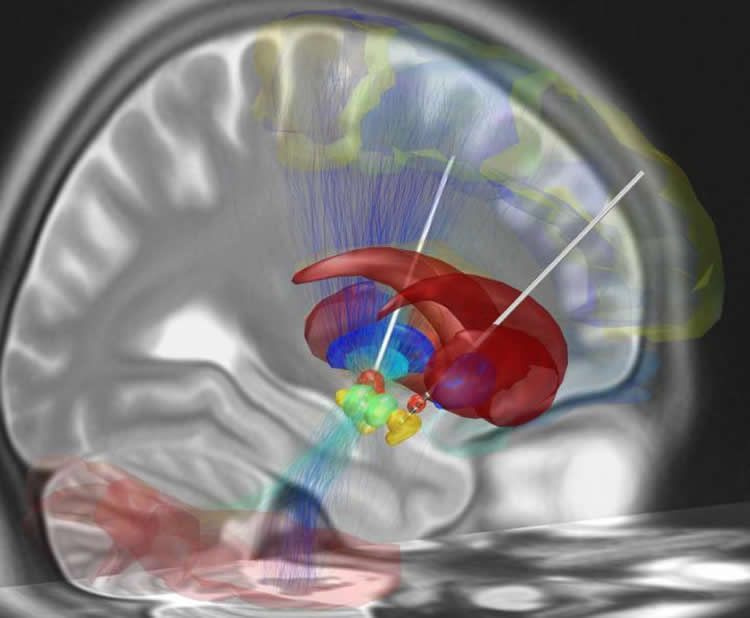Have you had the experience of being just on the verge of saying something when the phone rang? Did you then forget what it is you were going to say? A study of the brain’s electrical activity offers a new explanation of how that happens.
Published in Nature Communications, the study comes from the lab of neuroscientist Adam Aron at the University of California San Diego, together with collaborators at Oxford University in the UK, and was led by first author Jan Wessel, while a post-doctoral scholar in the Aron Lab. The researchers suggest that the same brain system that is involved in interrupting, or stopping, movement in our bodies also interrupts cognition — which, in the example of the phone ringing, derails your train of thought.
The findings may give insights into Parkinson’s disease, said Aron, a professor of psychology in the UC San Diego Division of Social Sciences, and Wessel, now an assistant professor of psychology and neurology at the University of Iowa. The disease can cause muscle tremors as well as slowed-down movement and facial expression. Parkinson’s patients may also present as the “opposite of distractible,” often with a thought stream so stable that it can seem hard to interrupt. The same brain system that is implicated in “over-stopping” motor activity in these patients, Aron said, might be also be keeping them over-focused.
The current study focuses particularly on one part of the brain’s stopping system — the subthalamic nucleus (STN). This is a small lens-shaped cluster of densely packed neurons in the midbrain and is part of the basal ganglia system.
Earlier research by Aron and colleagues had shown that the STN is engaged when action stopping is required. Specifically, it may be important, Aron said, for a “broad stop.” A broad stop is the sort of whole-body jolt we experience when, for example, we’re just about to exit an elevator and suddenly see that there’s another person standing right there on the other side of the doors.
The study analyzes signals from the scalp in 20 healthy subjects as well as signals from electrode implants in the STN of seven people with Parkinson’s disease. (The STN is the main target for therapeutic deep brain stimulation in Parkinson’s disease.)
All the volunteers were given a working memory task. On each trial, they were asked to hold in mind a string of letters, and then tested for recall. Most of the time, while they were maintaining the letters in mind, and before the recall test, they were played a simple, single-frequency tone. On a minority of trials, this sound was replaced by a birdsong segment – which is not startling like a “bang!” but is unexpected and surprising, like a cell phone chirping suddenly. The volunteers’ brain activity was recorded, as well as their accuracy in recalling the letters they’d been shown.
The results show, the researchers write, that unexpected events manifest the same brain signature as outright stopping of the body. They also recruit the STN. And the more the STN was engaged – or the more that part of the brain responded to the unexpected sound – the more it affected the subjects’ working memory and the more they lost hold of what they were trying to keep in mind.
“For now,” said Wessel, “we’ve shown that unexpected, or surprising, events recruit the same brain system we use to actively stop our actions, which, in turn, appears to influence the degree to which such surprising events affect our ongoing trains of thought.”
A role for the STN in stopping the body and interrupting working memory does fit anatomical models of how the nucleus is situated within circuitry in the brain. Yet more research is needed, the researchers write, to determine if there’s a causal link between the activity observed in the STN and the loss in working memory.
“An unexpected event appears to clear out what you were thinking,” Aron said. “The radically new idea is that just as the brain’s stopping mechanism is involved in stopping what we’re doing with our bodies it might also be responsible for interrupting and flushing out our thoughts.”
A possible future line of investigation, Aron said, is to see if the STN and associated circuitry plays a role in conditions characterized by distractibility, like Attention Deficit Hyperactivity Disorder. “This is highly speculative,” he said, “but it could be fruitful to explore if the STN is more readily triggered in ADHD.”

Wessel added: “It might also be potentially interesting to see if this system could be engaged deliberately – and actively used to interrupt intrusive thoughts or unwanted memories.”
If further research bears out the connection suggested by the current study, between the STN and losing your train of thought following an unexpected event, the researchers say it might be that it is an adaptive feature of the brain, something we evolved long ago as a way to clear our cognition and re-focus on something new. Aron suggests this example: You’re walking along one morning on the African Savannah, going to gather firewood. You’re daydreaming about the meal you’re going to prepare when you hear a rustle in the grass. You make a sudden stop – and all thoughts of dinner are gone as you shift your focus to figure out what might be in the grass. In this case, it’s a good thing to forget what you had been thinking about.
Aron and Wessel’s co-authors on the paper are: Ned Jenkinson of John Radcliffe Hospital at the University of Oxford, as well as the University of Birmingham (UK) and John-Stuart Brittain, Sarah H.E.M. Voets and Tipu Z. Aziz, also of Radcliffe Hospital at Oxford.
Funding: National Institutes of Health and the James S. McDonnell Foundation funded this study.
Source: Inga Kiderra – UCSD
Image Source: The image is credited to Andreashorn, license CC BY-SA 4.0 and adapted from the UCSD press release.
Original Research: Full open access research for “Surprise disrupts cognition via a fronto-basal ganglia suppressive mechanism” by Jan R. Wessel, Ned Jenkinson, John-Stuart Brittain, Sarah H. E. M. Voets, Tipu Z. Aziz and Adam R. Aron in Nature Communications. Published online April 18 2016 doi:10.1038/ncomms11195
Abstract
Surprise disrupts cognition via a fronto-basal ganglia suppressive mechanism
Surprising events markedly affect behaviour and cognition, yet the underlying mechanism is unclear. Surprise recruits a brain mechanism that globally suppresses motor activity, ostensibly via the subthalamic nucleus (STN) of the basal ganglia. Here, we tested whether this suppressive mechanism extends beyond skeletomotor suppression and also affects cognition (here, verbal working memory, WM). We recorded scalp-EEG (electrophysiology) in healthy participants and STN local field potentials in Parkinson’s patients during a task in which surprise disrupted WM. For scalp-EEG, surprising events engage the same independent neural signal component that indexes action stopping in a stop-signal task. Importantly, the degree of this recruitment mediates surprise-related WM decrements. Intracranially, STN activity is also increased post surprise, especially when WM is interrupted. These results suggest that surprise interrupts cognition via the same fronto-basal ganglia mechanism that interrupts action. This motivates a new neural theory of how cognition is interrupted, and how distraction arises after surprising events.
“Surprise disrupts cognition via a fronto-basal ganglia suppressive mechanism” by Jan R. Wessel, Ned Jenkinson, John-Stuart Brittain, Sarah H. E. M. Voets, Tipu Z. Aziz and Adam R. Aron in Nature Communications. Published online April 18 2016 doi:10.1038/ncomms11195






